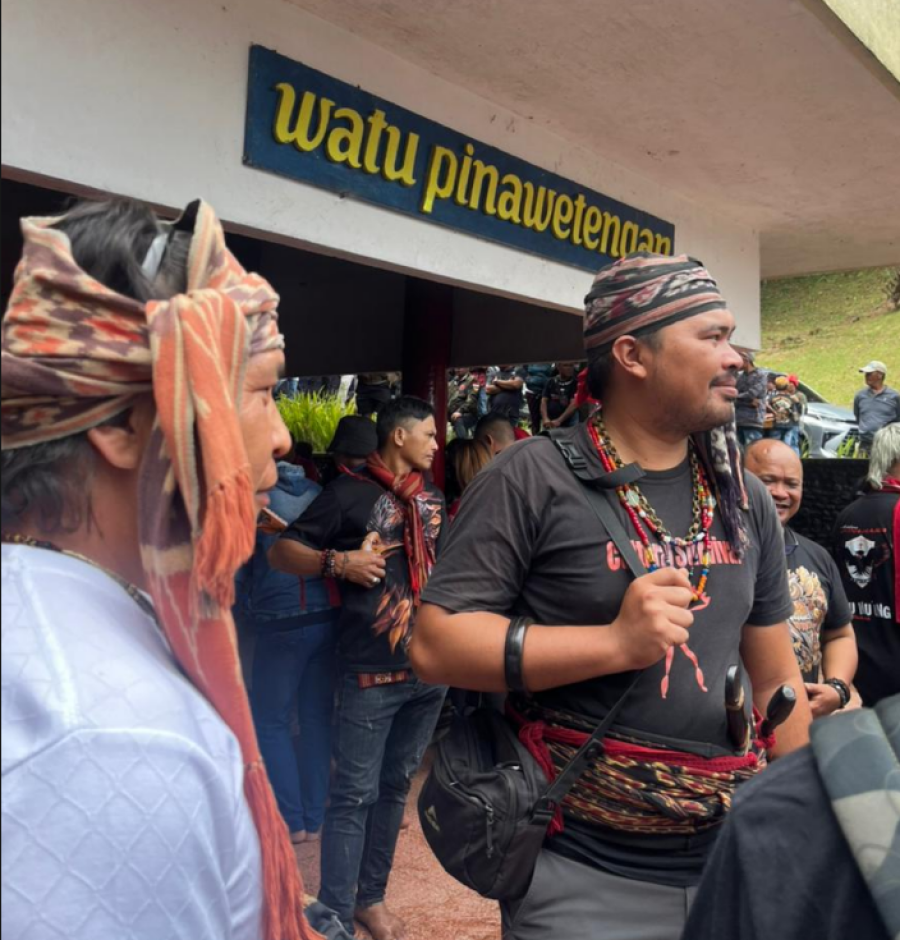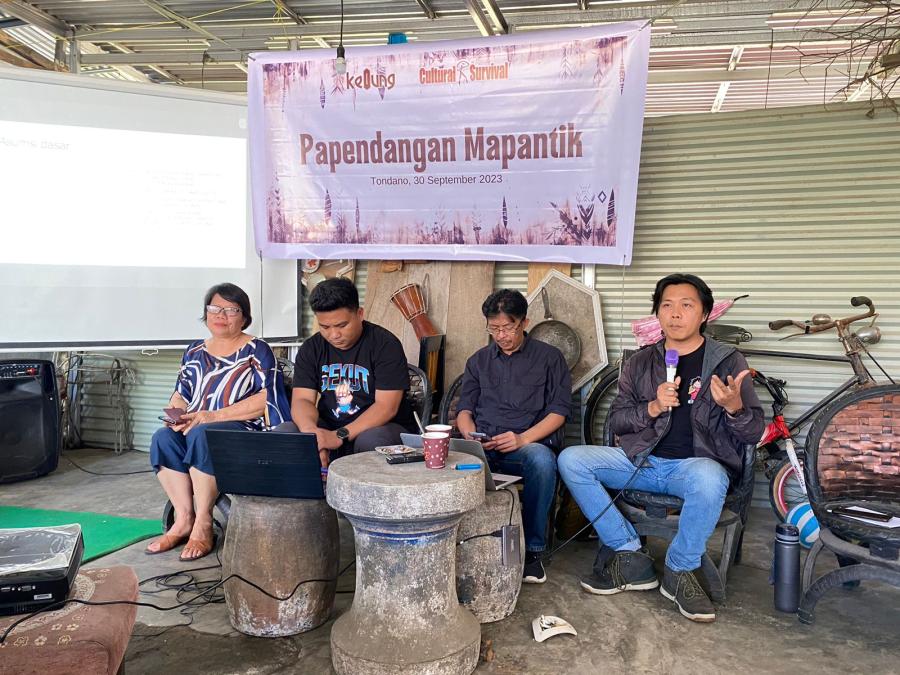In a remote corner of what used to be called Netherlands New Guinea, then West New Guinea, and is now known as Irian Jaya under the Indonesian government, some American missionaries have built a museum for local people. These people, the Asmat, are former headhunters and cannibals who made carvings for elaborate and continuous rituals and feasts that were armed to placate ancestral spirits.
The Asmat believe that death occurs only through magic or murder. Spirits of the dead demand vengeance. Only through the death of an enemy are spirits of the murdered individual appeased and leave the land of the living for the land of the dead. Only through death can life begin.
During the initiation ceremony of an Asmat boy, the initiate sits for three days with the decapitated head of an enemy at his groin, absorbing the dead man's essence through his penis. He then begins the rites of passage that take him to manhood.
All carvings in Asmat are named for the dead and are meant to remind the living of their obligation to avenge the murders. Every object, every spear, drum, paddle, food bowl, housepost, carrying bag, bamboo horn - everything the Asmat make, in fact - is named for a person who has recently died, whose spirit will remain in the village until vengeance has been taken.
Many carvings are made for specific rituals. Great ancestor poles are carved for headhunting and initiation rites among the Bisman people of the coast. Other areas have equally complex ritual objects, such as the immense soul ships of the Simai people. Each of the five main Asmat areas had its own initiation ceremonies that demand specific carvings.
In 1953 the first Westerner to establish a permanent station in Asmat, a Dutch Father settled outside the village of Sjuru in a place known as Agats which quickly became the government seat and the center of trading activities. Before the Father's arrival the Asmat had had little contact with the outside world. Terror of the Asmat warfaring ways led to violent encounters with outsiders. Today Asmat warfare has subsided. There are occasional flare-ups between villages and even within villages, but true warfare has disappeared in the areas under government control or missionary influence. On the borders of the Kombai and Koroway people, where there has been little outside contact, violence continues.
When the Indonesian government forced itself upon the people of Irian Jaya, officials in Asmat banned feasting and burned all houses and carvings they found. Indonesian officials, teachers, and merchants constantly referred to the Asmat as "animals" and insisted that they themselves had come to teach the Asmat "to become human." All aspects of Asmat life were to be discarded and replaced by the cultures of the newcomers, including those of the Mimikan catechists - themselves only recently subdued by Indonesian armed forces - who sneered at the Asmat use of shell nosepieces while encouraging them to conform to their own custom of filing their teeth to sharp points. New attitudes toward local culture dissipated many aspects of Asmat life. All carving disappeared except for items used in daily life, such as canoes, paddles, bows and arrows, and spears.
THE ASMAT MUSEUM
The Crosier Fathers, of Hastings, Nebraska, came to Asmat before Indonesia took over West New Guinea. When the complete destruction of Asmat culture appeared inevitable Bishop Sowada and Father Trenkenshuh gathered many ritual artifacts and objects of material culture and decided to build a museum. The John D. Rockefeller II Fund offered $20,000 in matching funds and other financial aid, and the Asia Foundation of Jakarta gave a library and training grant.
The Asmat Museum of Culture & Progress opened in August of 1973, created and designed as a place in which the Asmat could look at their past and present, and partake of the ambience of their culture, and form relationships with the housed artifacts. The purpose of the museum was to keep the Asmat from losing their sense of identity. Its most important contribution, however, was to expand and evolve the consciousness of the Asmat concerning the value of their past and their art. Thus the museum not only preserved the old but revived and stimulated carving. In addition, it was a place of learning, where educational and recreational films and slides were viewed.
Tourists occasionally visit Asmat, but never number even one hundred per year. In the museum descriptive material is translated into English as well as Indonesian and, in the case of nomenclature, into Asmat as well. The use of Asmat was avoided when possible due to the cumbersome quality of trilingual labels and the fact that all Asmat who can read, read and understand Indonesian. Ritual objects are labelled with Asmat names since some of them have no English or Indonesian equivalents.
As Director of Research and Documentation at the museum I sometimes set up displays. After having been in Asmat for several months it was decided to build an Asmat house in the museum. This project was revealing both to locals and myself.
The Asmat constructed the house. However, I felt capable of filling the house with artifacts and items I had seen in many Asmat houses. When I had finished arranging these items, a small group of men appraised my work. After the laughter died down, their leader pointed out the errors. Not one item I had placed inside the house was in its proper place. They already knew that outsiders were ignorant of their ways but the Asmat interior proved my stupidity once again.
The discarded mussel shells, always on the floor of every house, should never have been dumped in front of the man's place in front of the fireplace; they belonged on the women's side. The man's place must be clean and there should have been a bamboo horn on the floor so that the man could support his knee when he sat down or use it as a pillow at night.
Women's skirts never hang together. Each wife has a separate position.
The human skulls that had been taken in battle may not simply be strung together but each skull must be knotted individually onto the single cord. The cord is then hung close to the doorway.
The man's paddle is placed at an angle at the entranceway so that the upper end, with its decorative sleeve of white cockatoo feathers, Is outside, while the blade is stuck into the floorboards inside the house. His hair sticks of white cockatoo feathers are set into the cross-piece next to the paddle, enabling the man to grab his paddle and hair decorations quickly in case of attack.
The list of corrections pertained to every object in the house.
When the room was opened to the public, it became the second-most fascinating display. People sometimes paddled two and three days downstream to see it. The fact that Westerners had taken the trouble to put together an Asmat house so carefully intrigued them.
The most exciting display, particularly for the young who could easily grasp what they were seeing, turned out to be a wall of photographs taken in Asmat in the late 1950s and early 1960s, when the people were still relatively isolated. The Asmat openly expressed their emotions and sounds of exclamation and delight came from almost every visitor.
Important to an Asmat's understanding of any object is not only its visual appearance but its feel and smell. For this reason, there are no signs saying, "Please do not touch." This, in any case, would have been ignored by most people since so few are able to read. All displays are designed so that the visitor can pick up artifacts in the normal Asmat way. Unfortunately, as more and more Indonesians from other islands came into the museum, primarily to use the library (they had no interest in the artifacts, which they felt inferior to Balinese carving), objects began to disappear, especially those pieces that could be sold easily. The smallest objects, such as nosepieces and necklaces, were put under glass, while the bamboo horns, pipes, and other medium-sized carvings were tied down with long strings of nylon that allowed the pieces to be handled but not removed.
Older people was well as the young are fascinated with the museum but even now they are uncertain of its purpose. Even so, they enter to wonder at the artifacts, the Asmat house, the photographs, at their own past, and at the building itself.
The experience of a friend, was one that was repeated often. He needed courage and comfort the first time he entered. I sat on the ironwood floor with him while he smoked and talked and became accustomed to the atmosphere in which spirits from all parts of Asmat dwelt. Finally, an expression of shock, delight, thrill, and love, plus emotions I could not interpret, came from the single exclamation, "We-e-e-e-e-e!" he got up and went to the larger of the two syrinx aruanus shells on display. He picked it up carefully, cradled it, cuddled it in the crook of an arm, nuzzled it between his cheek and shoulder, placed it against his naked abdomen in the position he would have worn it in the past to indicate his prowess as a great headhunter, focusing his eyes into what I imagined was his past life of violence and excitement, the life that was no longer in existence. He went about the museum touching everything of importance, ignoring the newer objects with outside influence. He wondered, too, at the size and use of the museum and how many people slept in that immense building, until he learned there were no fireplaces and no mats on which to sleep.
Youngsters at the museum were startled in different ways. Some were frightened by the sight of the human skulls on display. Most of the young came from the Catholic junior high school, the only secondary school in Asmat. It is just next door to the museum, and visits are part of the curriculum. They go into the display rooms and library (the only public library in Irian Jaya) several times a week. On occasion, students and the public are invited to film showings and lectures at night when the Catholic mission turns on its generator for three hours. But it is the photographs that most attract the young, for they often recognize members of their families and tell stories of the way life used to be.
The Asmat museum has influenced the revival of carving as well. For the first time many carvers whose works are on display see the importance of their work to outsiders. This gives them a rare sense of pride and stimulates all carvers to make new pieces, some of which are bought by the museum. The relaxation of the official ban on feasts and carving has also allowed the carvers to work on objects commissioned by the museum, pieces not in its collection yet central to feasts that had not taken place for twenty or more years. These carvings, in turn, revived the feasts since it was not possible for the Asmat to make the ritual object without the feast that celebrated it.
This renewal of some aspects of the culture may be no more than a passing phase, but it does permit the young to see and live through rituals that had not been available to them earlier and it preserves works and the richness of Asmat history for their descendants.
Article copyright Cultural Survival, Inc.



